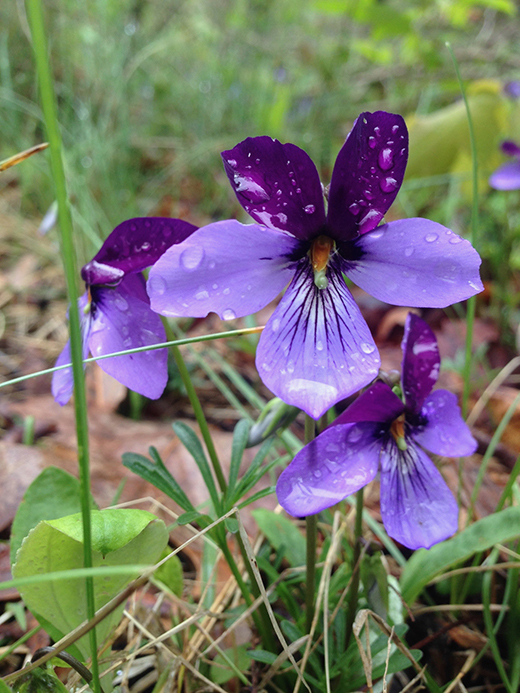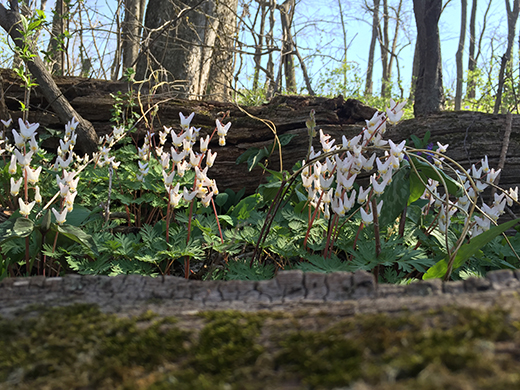
MIKE MILLER
It wouldn’t be spring without the flush of new, green growth that happens each year in our woods and prairies of Central Illinois. There is that magical time, before the trees have fully leafed out, when sunlight streams through the canopy and reaches the forest floor. This is the realm of the spring ephemeral wildflower. Those unique species of native plants that pop from the cool earth and bless the viewer with their quick and beautiful life cycle. Each day, a new species is added to the mix. All too quickly, these jewels of the forest can disappear, their life cycle done for another 12 months. It pays to be a frequent visitor to the April woods. If you are, here are a few of the gems you will find.
The Virginia Bluebell (Mertensia virginica) blooms in vast carpets of blue along the terraces of creeks throughout Illinois. It is one of the most numerous and beautiful native wildflower that graces a healthy stream valley. Bluebells are somewhat a color chameleon as they grow. The young plants start as clusters of purple leaves that break the soil. As they grow, they turn vivid green. The flower buds that grace the top of the greenery start out apple blossom pink, then morph into a purple-rose as they develop, and finally open to an incomparable blue which no other Illinois wildflower can quite approach. Their peak bloom can run for a week or two, usually starting in mid to late April. By late May, all signs of their existence are gone, and their habitat will morph into a deep, dark forest, as the trees fully leaf-out and block the sunlight from reaching the forest floor. The graceful blooms of bluebells will quickly give way to a tangle of nettles in the rich soil of the valley.
Scattered among the Bluebells, and climbing part way up the drier slopes, grow the Dutchman’s Breeches (Dicentra cucullaria). These plants grow from pinkish bulblets just below the surface of the soil. Out from the soil unfurl feathery, graceful leaves. A pinkish stem arches above the cluster of leaves and is adorned with a row of some of the most unusual flowers to grace our springtime woods. Often describes as “tiny pantaloons” complete with two legs pointing skyward and a yellow waistline pointing down, the idea that some tiny forest resident has hung out their laundry isn’t too far fetched.

Bird’s-foot violets emerge each spring at Singing Woods Nature Preserve, primarily along upland sites. (PHOTO BY MIKE MILLER)
Far above the valley, on the ridge-top among wide-spaced and twisted Chinquapin Oaks is the habitat for one of our most graceful versions of a common wildflower that can grow in our lawns. There are several species of violets native to Illinois, but the seldom seen Bird’s-foot Violet (Viola pedata) is a real beauty. The leaves are deeply cut into narrow lobes, giving them a distinctive shape that is much different from the common Blue Violet that we find in our yards. The flowers are also larger than other violets. Combined with the small leaves, they almost seem a top-heavy exaggeration of a violet. In Central Illinois, our bluff-tops are blessed with a unique regional variety that sports a dandy of a flower. The top two petals are a deep, dark purple, while the lower three petals are a lilac-blue. Punctuating the whole color spectacle are vivid orange stamens that are icing on the cake.
Spring is over all too quickly, so don’t delay getting out and enjoying this fleeting season. If you would like to join a Peoria Park District naturalist on a spring walk, there are several opportunities available:
At Forest Park Nature Center
Wildflower Walks, 10 a.m. Wednesdays, April 18 and May 2
Signs of Spring Walk, 1:30 p.m. Sunday, April 29
At Tawny Oaks Field Station
Wildflower Walk, 9 a.m., Saturday, April 7
Singing Woods Hike, 9 a.m., Saturday, April 14

These Dutchman’s Breeches emerge each spring at Singing Woods Nature Preserve. They are among the first spring ephemerals in Central Illinois, and viewing them cannot be postponed because their quick and beautiful life cycle ends too soon. (PHOTO BY MIKE MILLER)

Recent Comments